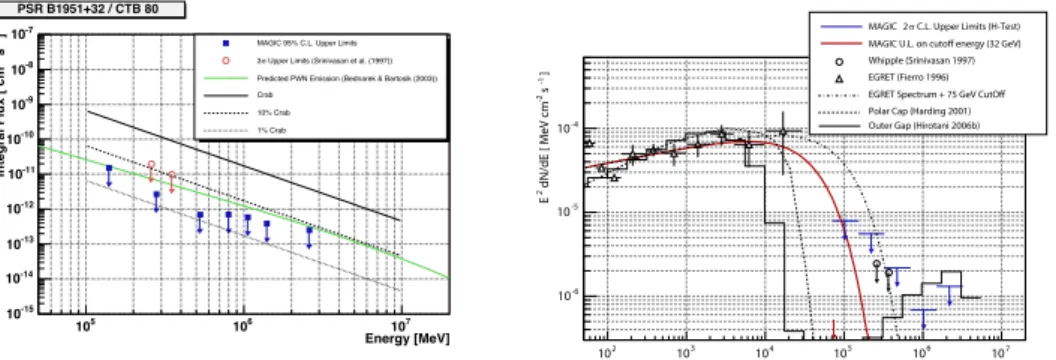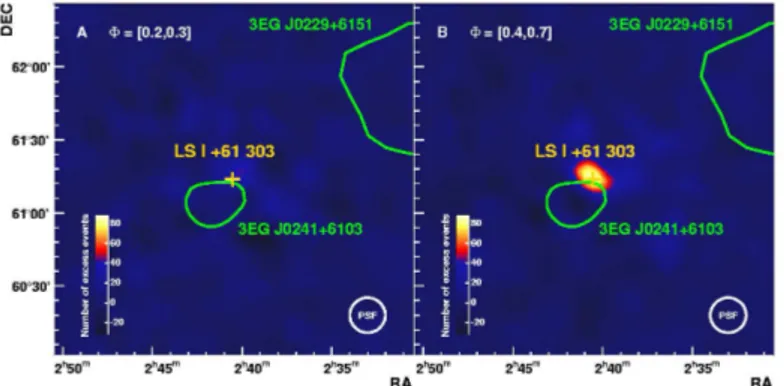Highlights of MAGIC observations of galactic sources
Diego F. Torres ∗ , Juan Cortina † and for the MAGIC collaboration ∗∗
∗ ICREA and Institut de Cienciès de l’Espai, IEEC-CSIC, E-08193 (Barcelona) Spain
† Institut de Física d’Altes Energies, Edifici Cn., E-08193 (Barcelona), Spain
∗∗ Updated collaborator list at
http://wwwmagic.mppmu.mpg.de/collaboration/members
Abstract. During its first cycle, the MAGIC (Major Atmospheric Gamma-ray Imaging Cherenkov) telescope was performing an observational campaign covering a total of about 250 hours on galactic sources. Here we review the results for the very high energy ( > 100 GeV) γ -ray emission from some of those sources. We focus on LS I +61 303 and PSR 1951+32.
THE MAGIC TELESCOPE
The Major Atmospheric Gamma Imaging Cherenkov (MAGIC) telescope is a very high energy (VHE) γ -ray telescope, operating in an energy band from 100 GeV to 10 TeV, exploiting the Imaging Air Cherenkov technique. Located on the Canary Island of La Palma, 2250 m above sea level, the telescope has a 17-m diameter tessellated parabolic mirror, and is equipped with a 3.5 ◦ -3.8 ◦ field of view camera. In this work we leave aside published results on SNRs ([1, 2]) and the Galactic Center ([3]) to showcase the released highlights on pulsars and X-ray binaries observations.
A HIGHLIGHT FROM PULSARS OBSERVATIONS
Based on results from EGRET, we know that pulsars have relativistic particles in their
magnetospheres, that emit γ -rays up to energies of several GeV. PSR B1951+32 is
a prime candidate for observation by ground based γ -ray detectors with low energy
thresholds: Its spin down age is ∼ 10 5 years, i.e. about 100 times older than the Crab
pulsar. The magnetic field strength of 4 . 9 · 10 11 G is lower than in most rotation-powered
pulsars. It is therefore expected that the screening of γ -rays due to pair production in
the magnetosphere is reduced and the cutoff of the high energy emission subsequently
shifts to higher energies. For references and more detailed discussion on PSR 1951+32
see [4]. The pulsar is located in the core of the radio nebula CTB 80, thought to be
physically associated with the pulsar. The current tightest constraint on the > 100 GeV
emission from the pulsar and its nebula, obtained by the Whipple collaboration [5], puts
an upper limit of 75 GeV on the cutoff energy of the pulsed emission and an upper limit
of ≤ 1 . 95 × 10 −11 cm −2 s −1 on the > 260 GeV steady emission. In total 30.7 hours of
MAGIC data were processed. The zenith angle range of the observation was restricted
to between 5 ◦ and 25 ◦ , guaranteeing the lowest possible energy threshold. We searched
for steady γ -ray emission from the direction of PSR B1951+32 with different analysis thresholds between 140 GeV and 2 . 6 TeV. As no significant signal ( > 5 σ ) of γ -rays was found, we calculated upper limits on the number of excess events with a confidence level of 95%. The limits on the integral flux of γ -rays are shown in Figure 1 (left panel), together with the measurement of [5] and the predictions of [6]. MAGIC has also performed a search for pulsed γ -ray emission from PSR B1951+32 in 5 differential bins of reconstructed energy between 100 GeV and 2 TeV. To test for periodicity we applied the Pearson- χ 2 -test, the H-Test and the Bayesian-Test (see [4] for details). No signature of pulsed emission was found in any of the energy intervals. From the result of the H-Test we calculated an upper limit on the number of excess events, from which we derived an upper limit on the cutoff energy of the pulsed emission. The measured spectrum of PSR B1951+32 at lower gamma-ray energies multiplied by an exponential cutoff of 32 GeV is shown as a solid red line in Figure 1 (right panel). The analysis threshold, 75 GeV, is marked with the red arrow in the figure.
Energy [MeV]
105 106 107
]-1 s-2Integral Flux [ cm
10-15 10-14 10-13 10-12 10-11 10-10 10-9 10-8 10-7
MAGIC 95% C.L. Upper Limits Upper Limits (Srinivasan et al. (1997)) 3σ
Predicted PWN Emission (Bednarek & Bartosik (2003)) Crab
10% Crab 1% Crab
PSR B1951+32 / CTB 80
Energy [MeV]
102 103 104 105 106 107
]-1 s-2 dN/dE [ MeV cm2E
10-6 10-5 10-4
C.L. Upper Limits (H-Test) MAGIC 2σ
MAGIC U.L. on cutoff energy (32 GeV) Whipple (Srinivasan 1997) EGRET (Fierro 1996) EGRET Spectrum + 75 GeV CutOff Polar Cap (Harding 2001) Outer Gap (Hirotani 2006b)

